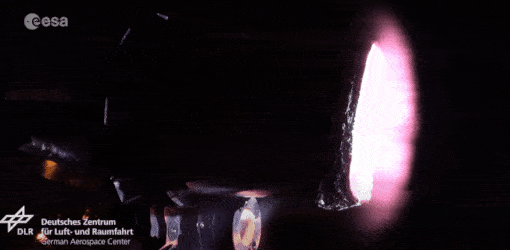
Copernical Team
Spacewalking astronauts boosting station's solar power

Astronauts ventured out on a spacewalk Wednesday to outfit the International Space Station with powerful, new solar panels to handle the growing electrical demands from upcoming visitors.
It's the first of a series of spacewalks to equip the aging orbital outpost with smaller but stronger solar wings.
Space embrace: Astronauts and robots work together to service the ISS

A robot must obey the orders given it by human beings, according to one of the three laws of robotics imagined by science fiction writer Isaac Asimov. On board humanity's only outpost in space, this obedience has turned into cooperation. Astronauts and robots are working together.
The latest robot to service the International Space Station is the European Robotic Arm (ERA). This android automaton is much like a human arm. It has an elbow, shoulders and even wrists, and it the first robot able to 'walk' around the Russian part of the Space Station.
The arm will be launched into space together with the Multipurpose Laboratory Module, called "Nauka," from the Baikonur Cosmodrome, in Kazakhstan, on 15 July 2021.
ESA astronaut André Kuipers is seen in this picture during his first space mission in 2004, with a scale model of the European Robotic Arm. The real thing has a length of over 11 m, and has the ability to anchor itself to the Station in multiple locations, moving backwards and forwards with a large range of motion.
"I am happy to see the European Robotic Arm fly next month.
Register for Φ-week 2021

Register for Φ-week
Drive to destruction
 Image:
Drive to destruction
Image:
Drive to destruction China to launch first crew to new space station on Thursday

Astronauts blasting off on Thursday for China's first manned mission to its new space station will have a choice of 120 different types of food and "space treadmills" for exercise during their stay, China's space agency said.
The mission will be China's longest crewed space mission to date and the first in nearly five years, as Beijing pushes forward with its ambitious programme to establish itself as a space power.
The astronauts will spend three months onboard the station, which has separate living modules for each of them, as well as a shared bathroom, dining area, and a communication centre to send emails and allow two-way video calls with ground control.
The trio will be able to work off their range of dinner options—which officials assured reporters were all both nutritious and tasty—on the space treadmills or bicycles.
European Robotic Arm enters service on the ISS
 A robot must obey the orders given it by human beings, according to one of the three laws of robotics imagined by science fiction writer Isaac Asimov. On board humanity's only outpost in space, this obedience has turned into cooperation. Astronauts and robots are working together.
The latest robot to service the International Space Station is the European Robotic Arm (ERA). This android au
A robot must obey the orders given it by human beings, according to one of the three laws of robotics imagined by science fiction writer Isaac Asimov. On board humanity's only outpost in space, this obedience has turned into cooperation. Astronauts and robots are working together.
The latest robot to service the International Space Station is the European Robotic Arm (ERA). This android au SES Renews Long-Term Relationship with Comcast Technology Solutions
 SES will continue delivering Comcast Technology Solutions' Managed Satellite Distribution service, formerly known as Headend in the Sky (HITS), that reaches hundreds of multichannel video programming distributor systems across the US.
SES recently renewed its long-term relationship with Comcast Technology Solutions (CTS), a division of Comcast Cable that provides media and entertainment te
SES will continue delivering Comcast Technology Solutions' Managed Satellite Distribution service, formerly known as Headend in the Sky (HITS), that reaches hundreds of multichannel video programming distributor systems across the US.
SES recently renewed its long-term relationship with Comcast Technology Solutions (CTS), a division of Comcast Cable that provides media and entertainment te A Probing Question: How Do You Fly the X-59 Accurately?
 Mountains of data will be required if NASA's X-59 Quiet SuperSonic Technology airplane is going to help change the future of commercial supersonic flight over land, and a sophisticated suite of instruments is needed in the air and on the ground to collect it.
On the aircraft, these instruments are known as the air data system. A computer takes input from probes, sensors, and other devices
Mountains of data will be required if NASA's X-59 Quiet SuperSonic Technology airplane is going to help change the future of commercial supersonic flight over land, and a sophisticated suite of instruments is needed in the air and on the ground to collect it.
On the aircraft, these instruments are known as the air data system. A computer takes input from probes, sensors, and other devices Total solar eclipses shine a light on the solar wind with help from NASA's ACE Mission
 From traversing sand dunes in the Sahara Desert to keeping watch for polar bears in the Arctic, a group of solar scientists known as the "Solar Wind Sherpas" led by Shadia Habbal, have traveled to the ends of the Earth to scientifically observe total solar eclipses - the fleeting moments when the Moon completely blocks the Sun, temporarily turning day into night. With the images, they've uncover
From traversing sand dunes in the Sahara Desert to keeping watch for polar bears in the Arctic, a group of solar scientists known as the "Solar Wind Sherpas" led by Shadia Habbal, have traveled to the ends of the Earth to scientifically observe total solar eclipses - the fleeting moments when the Moon completely blocks the Sun, temporarily turning day into night. With the images, they've uncover Coronal mass ejections and cosmic ray observations at Syowa Station in the Antarctic
 Solar activities, such as CME(Coronal Mass Ejection), cause geomagnetic storm that is a temporary disturbance of the Earth's magnetosphere. Geomagnetic storms can affect GPS positioning, radio communication, and power transmission system.
Solar explosions also emit radiation, which can affect satellite failures, radiation exposure to aircraft crew, and space activity. Therefore, it is impo
Solar activities, such as CME(Coronal Mass Ejection), cause geomagnetic storm that is a temporary disturbance of the Earth's magnetosphere. Geomagnetic storms can affect GPS positioning, radio communication, and power transmission system.
Solar explosions also emit radiation, which can affect satellite failures, radiation exposure to aircraft crew, and space activity. Therefore, it is impo 
